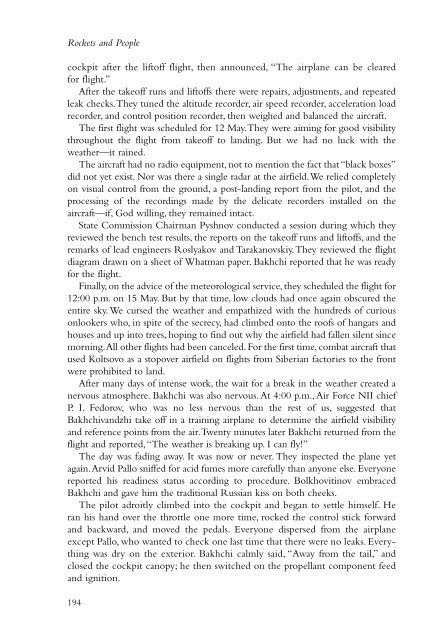to open next chapter. - NASA's History Office
to open next chapter. - NASA's History Office
to open next chapter. - NASA's History Office
Create successful ePaper yourself
Turn your PDF publications into a flip-book with our unique Google optimized e-Paper software.
Rockets and People<br />
cockpit after the lif<strong>to</strong>ff flight, then announced, “The airplane can be cleared<br />
for flight.”<br />
After the takeoff runs and lif<strong>to</strong>ffs there were repairs, adjustments, and repeated<br />
leak checks.They tuned the altitude recorder, air speed recorder, acceleration load<br />
recorder, and control position recorder, then weighed and balanced the aircraft.<br />
The first flight was scheduled for 12 May.They were aiming for good visibility<br />
throughout the flight from takeoff <strong>to</strong> landing. But we had no luck with the<br />
weather—it rained.<br />
The aircraft had no radio equipment, not <strong>to</strong> mention the fact that “black boxes”<br />
did not yet exist. Nor was there a single radar at the airfield.We relied completely<br />
on visual control from the ground, a post-landing report from the pilot, and the<br />
processing of the recordings made by the delicate recorders installed on the<br />
aircraft—if, God willing, they remained intact.<br />
State Commission Chairman Pyshnov conducted a session during which they<br />
reviewed the bench test results, the reports on the takeoff runs and lif<strong>to</strong>ffs, and the<br />
remarks of lead engineers Roslyakov and Tarakanovskiy.They reviewed the flight<br />
diagram drawn on a sheet of Whatman paper. Bakhchi reported that he was ready<br />
for the flight.<br />
Finally, on the advice of the meteorological service, they scheduled the flight for<br />
12:00 p.m. on 15 May. But by that time, low clouds had once again obscured the<br />
entire sky.We cursed the weather and empathized with the hundreds of curious<br />
onlookers who, in spite of the secrecy, had climbed on<strong>to</strong> the roofs of hangars and<br />
houses and up in<strong>to</strong> trees, hoping <strong>to</strong> find out why the airfield had fallen silent since<br />
morning.All other flights had been canceled. For the first time, combat aircraft that<br />
used Koltsovo as a s<strong>to</strong>pover airfield on flights from Siberian fac<strong>to</strong>ries <strong>to</strong> the front<br />
were prohibited <strong>to</strong> land.<br />
After many days of intense work, the wait for a break in the weather created a<br />
nervous atmosphere. Bakhchi was also nervous. At 4:00 p.m., Air Force NII chief<br />
P. I. Fedorov, who was no less nervous than the rest of us, suggested that<br />
Bakhchivandzhi take off in a training airplane <strong>to</strong> determine the airfield visibility<br />
and reference points from the air.Twenty minutes later Bakhchi returned from the<br />
flight and reported,“The weather is breaking up. I can fly!”<br />
The day was fading away. It was now or never. They inspected the plane yet<br />
again.Arvid Pallo sniffed for acid fumes more carefully than anyone else. Everyone<br />
reported his readiness status according <strong>to</strong> procedure. Bolkhovitinov embraced<br />
Bakhchi and gave him the traditional Russian kiss on both cheeks.<br />
The pilot adroitly climbed in<strong>to</strong> the cockpit and began <strong>to</strong> settle himself. He<br />
ran his hand over the throttle one more time, rocked the control stick forward<br />
and backward, and moved the pedals. Everyone dispersed from the airplane<br />
except Pallo, who wanted <strong>to</strong> check one last time that there were no leaks. Everything<br />
was dry on the exterior. Bakhchi calmly said, “Away from the tail,” and<br />
closed the cockpit canopy; he then switched on the propellant component feed<br />
and ignition.<br />
194
















